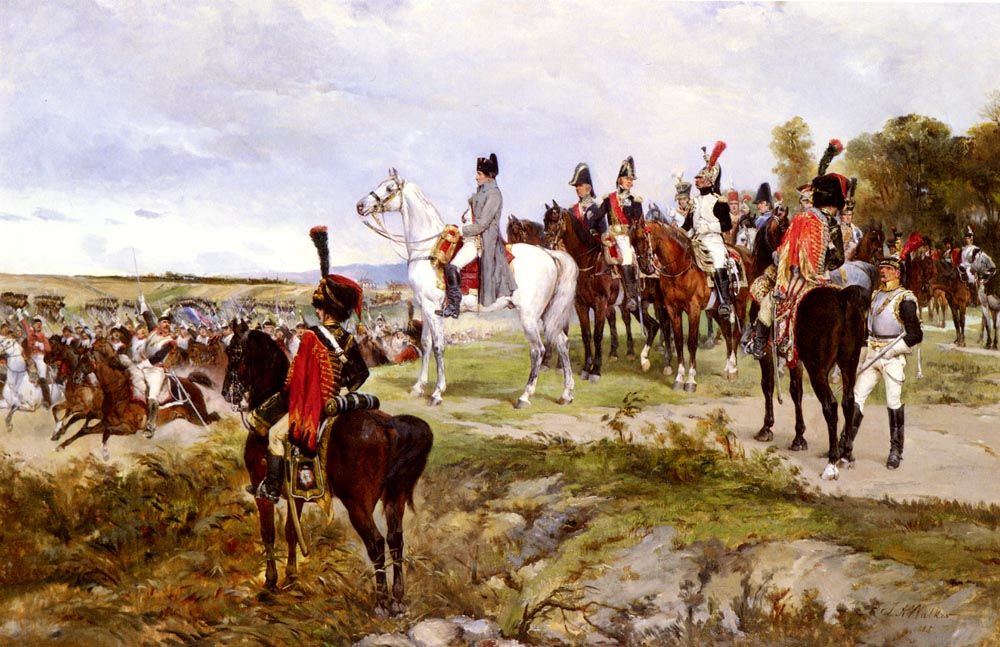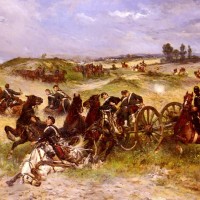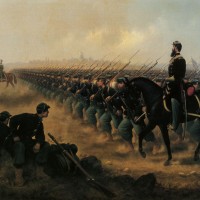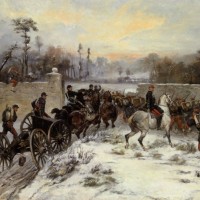| Painting Name | Napoleon Watching The Battle Of Friedland 1807 |
| Painter Name | James Alexander Walker |
| Completion Date | 1855 |
| Size | 152.3 x 99 cm (4' 11.96" x 3' 2.98") |
| Technique | Oil |
| Material | Canvas |
| Current Location | Private collection |
Painted around 50 years later from the year in which the Battle took place, Napoleon Watching The Battle of Friedland is an oil on canvas painting by James Alexander Walker completed in 1855. It is currently residing in a private collection and lengths around 5 by 3 feet in both dimensions. It is commemorating one of the Napoleonic wars – The Battle of Friedland, being one of the Coalition Wars between two rivals, Napoleon being on one side and Prussia, Russia, Saxony, Sweden and United Kingdom being the rival side combined. And still the combined powers of those countries were not enough to defeat Napoleon’s thrashing march of winning over the world.
Napoleon, on the white horse, is watching over his army marching towards the battlefield near the Alle River at Friedland. About nine hours ago the 58000 Russians crossed the river and attacked the seemingly isolated troop of Marshal Jean Lennes believing they have involved in an easy win in which they were outnumbering the French for two against one soldier. Though, the French troop did gave a very good fight to the Russians and held them at the banks of the river for nearly nine hours after Napoleon’s real plan got revealed when he released the rest of his army numbering around 65000, upon the Russians and total number of French army reached at 80000 which was staggeringly high for the Russians who had been fighting for more than nine hours, got tired and already had lost a considerable part of its troop. The later wave of the large French army put them in a shock. Being shattered by the fear and discouraged, Russians lost around 19000 soldiers against French loss of 9000. Moreover, the Prussian help Russians were getting also got derived out of fear when the Prussian general Anton Lestocq fled away from the war with his 25000 soldiers. The leftover Russians were in no power of keeping the fight on anymore. They lost badly.
The win proved big as Napoleon troop acquired Konigsberg and later on signed two treaties of wars with Russia and Prussia, called Treaties of Tilsit. The Russian king Tsar Alexander I of Russia signed the treaty on July 7 while the Prussian king on July 9. The treaties ended the battle of Friedland, resulting in Napoleon’s win over the lands. Though, it was not the end of the Coalition between European countries against the France as there was another War of Coalition happened two years after the battle of Friedland, when Austria and Great Britain got together to defeat the French Giant.
Napoleon spent most of his life on the battlegrounds and strategically won one by one wars and Battle of Friedland was no exception in his grand winnings. Some would say he was lucky, I would say his desire to win was far greater than the allied powers and will to defeat him and if he had lived longer, he may have fulfilled his desire of winning over the world on some unfortunate day.
His central position in the picture surrounded by his comrades and captains reflects his importance. He is strategically watching over his marching troop about which win is his sure of. The marching soldiers are giving a honoring look and cheers of wars to their commander. The captains around him are waiting for further commands. Thus, the whole picture is showcasing the one and only Napoleon’s power and influence over his soldiers and captains as well as the disciplined rage in everyone’s mind to win the task which their commander has assigned them all to conquer.




